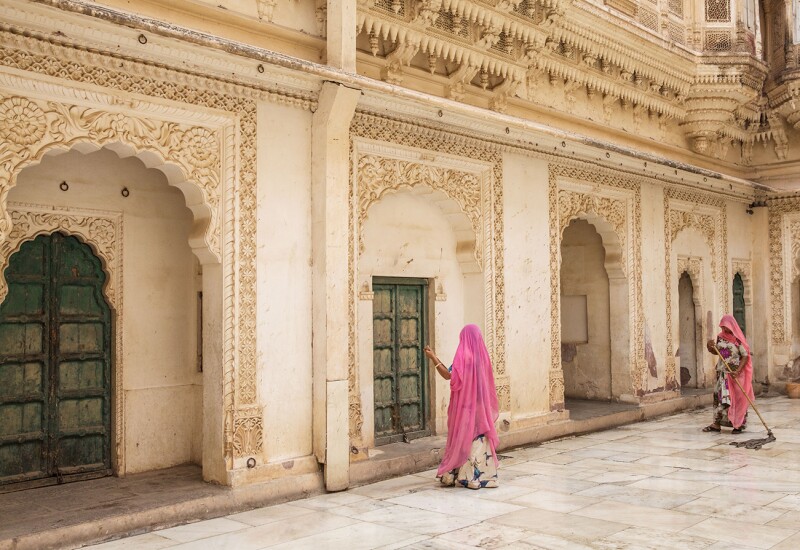In Rajasthan, India’s largest state, many cities are nicknamed after specific colors. The capital, Jaipur, is commonly referred to as the “Pink City” due to its abundance of buildings painted in the delicate hue, and Jodhpur, the region’s second major metropolis, is dubbed the “Blue City” for a similar reason. Jaisalmer, located in the heart of the arid Thar Desert, is distinguished as the “Golden City” for its yellow sandstone architecture.
None of this is a coincidence. “Color—in rich, vibrant hues—defines every aspect of life in India,” says photographer Christine Chitnis, who spent a decade documenting colorful scenes across northwestern India for her new book, Patterns of India: A Journey Through Colors, Textiles, and the Vibrancy of Rajasthan (Clarkson Potter, 2020). The 288-page book is organized into five sections dedicated to prevalent colors across Rajasthan: sandstone, marigold, rose, ivory, and royal blue. Alongside Chitnis’s bright images of Rajasthani architecture, textiles, cuisine, markets, and other everyday scenes, essays written by Chitnis provide context for the cultural significance of the recurring color schemes at play.

“Patterns of India: A Journey Through Colors, Textiles, and the Vibrancy of Rajasthan” hit stands on March 3, 2020.
Courtesy of “Patterns of India” by Christine Chitnis, copyright © 2020. Published by Clarkson Potter, a division of Penguin Random House, LLC.
The project began more than a decade ago when Chitnis visited northwest India for the first time with her husband, Vijay, whose parents are from the country. “We’d be walking through a market and I’d think, ‘Oh my goodness, those mounds of turmeric echo the sari that woman is wearing, which echoes the marigold chains at the flower stalls. . . . I couldn’t get it out of my head,” Chitnis says.
Over the years, as Chitnis returned to Rajasthan on multiple occasions with her husband (and later, their three children), the photographer began to develop the idea for presenting a collection of images that represent Rajasthan specifically through this lens. “As I combed through my archives trying to choose photos to include in this book, one thing became clear to me—very specific color stories were at play in Rajasthan,” Chitnis writes in the book’s introduction. “Patterns occupied a central role,” she continues, referring to the decorative motifs used in traditional Indian arts and handicrafts such as hand block printing and weaving—whether they’re simple dots and lines or meaningful designs pulled from religious texts.

The 288-page book is organized into five sections dedicated to prevalent colors across the region—sandstone, marigold, rose, ivory, and royal blue.
Courtesy of “Patterns of India” by Christine Chitnis, copyright © 2020. Published by Clarkson Potter, a division of Penguin Random House, LLC.
The book showcases some of Rajasthan’s more famous majestic forts and palaces, from the golden sandstone Umaid Bhawan Palace in Jodhpur where the city’s royal family lives, to the Amer Fort and the Hawal Mahal in Jaipur, both constructed with red and pink sandstone. It also includes scenes from rural Rajasthan, such as a shot of villagers gathered on neutral-toned ghats (stairs) by a lake, and a close-up of naan (a leavened flatbread) being prepared in a tandoor, or a cylindrical clay oven. Other sections take readers through busy markets in Jaipur and Udaipur, where narrow streets overflow with sacks of marigolds and mounds of fire-toned spices such as cumin, turmeric, and saffron. Brief captions detail everything from the significance of saffron, the most sacred color for Hindus, to the ingredients of bhel puri, a popular Indian street food snack made with puffed rice and spices.

Alongside bright images of Rajasthani architecture, textiles, cuisine, markets, and other everyday scenes, essays written by Chitnis provide context for the cultural significance of the recurring colors and patterns at play.
Courtesy of “Patterns of India” by Christine Chitnis, copyright © 2020. Published by Clarkson Potter, a division of Penguin Random House, LLC.
“[In Rajasthan], every color is imbued with meaning,” writes Dr. Vandana Bhandari, a professor at New Delhi’s National Institute of Fashion Technology who studies the relationship between color and pattern in Rajasthan, in the foreword for Patterns of India. “It is often within the details of the pattern that the full story comes to light.”
While Chitnis asserts that her book isn’t a “comprehensive historical or cultural study of the region’s arts and crafts,” her goal, she says, is to offer further insight into Rajasthan’s “complex and layered” cultures. “Everyone talks about how colorful [Rajasthan] is,” Chitnis says. “I’m not a historian, but I feel like my responsibility as a traveler is to gain an understanding of the ways of life and the customs in [the places I visit]. I hope this book inspires people to look at their own travels in a different way, no matter where you go.
“It’s such an interesting way to start to see the world,” she continues. “To be a traveler is to pay heightened attention to the ordinary, so we can root our travels in knowledge and have context for what we see.”
Buy it: $27, amazon.com
Products we write about are independently vetted and recommended by our editors. We may earn a commission if you buy through our links.
>> Next: Airbnb Wants You to Live Like a Royal in Jaipur’s City Palace











